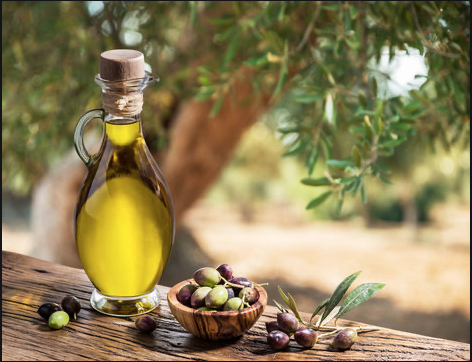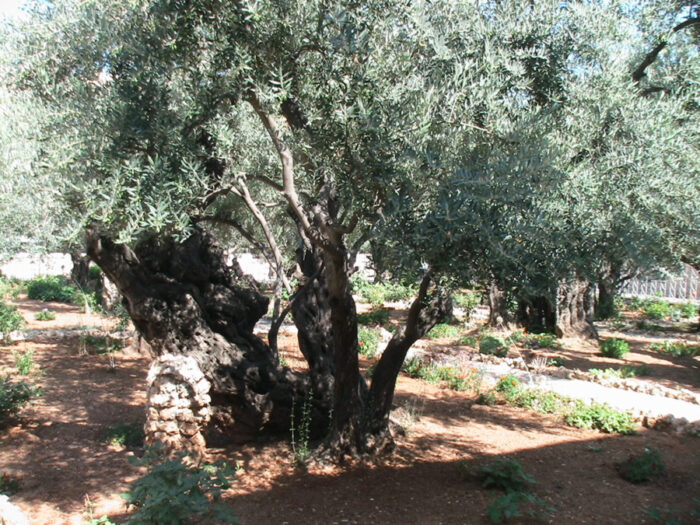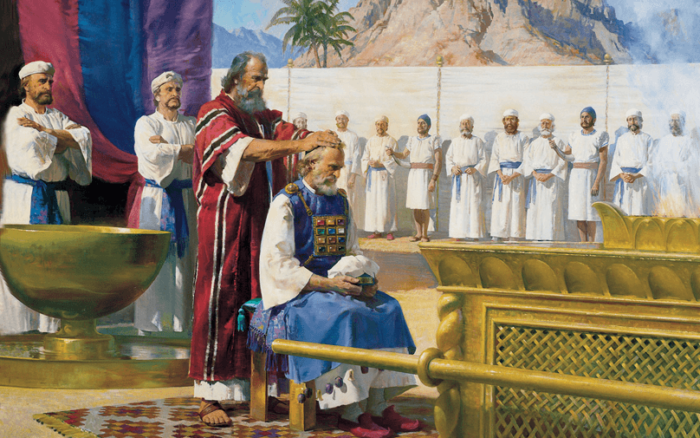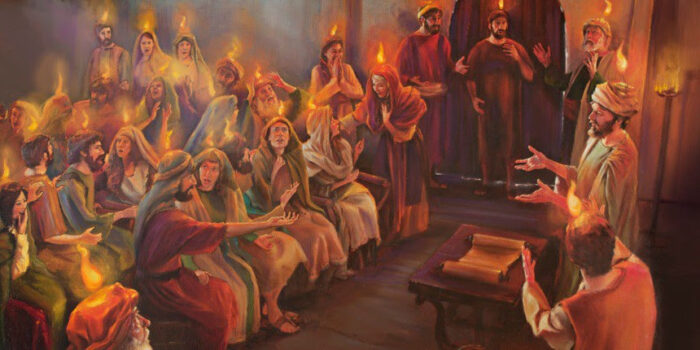
Olive Oil
Part of the beauty of the Olive Tree consists in its greenness, it is always green; few trees that bear fruit are like the Olive in this respect. (5)

Olive oil is produced by growing olive trees [see graphic above], harvesting the olives (around September), crushing them with an oil press, and collecting the golden juice. This process started about 5000 years ago, and its popularity and worth have increased. Olive oil was used as cooking oil, food, lighting fuel, soap making, religious ceremonies, and medicinal use. Its production was one of the major sources of income in Israel over thousands of years, including in modern times when olive oil is an essential ingredient in Middle Eastern cuisine. During the Roman and Byzantine periods, the number of oil presses was in the thousands; many farmers had private installations, and larger public industrial complexes generated a vast amount of olive oil. (3)
“The olive oil production process was based on two major steps. The first step involved crushing the olives using a crushing stone and then collecting them into a basket. The second step is done on another installation: the basket is pressed with force, extracting the oil out of the crushed olives and collecting the juice into a storage vat. Different machines were used for crushing the olives and pressing the oil out of the crushed olives. They differed in size, method of operation, use of human or animal power, infrastructure, and capacity. Most oil presses had a single crushing stone, basin, and one or two pressing devices.” (3)

The olive crusher (graphic above) used a large rolling stone to crush the olives. The stone was held upright by an axis connected to a long handle. The handle was pushed by humans or animals. The mashing stone rolled along a cavity on the circumference of the base, crushing the olives. The crushed olives would then be collected into a basket and processed by the olive press. (3)
The olive press device was the second step in olive oil production, where the crushed olives were pressed with force in order to extract their juice. (3)

(3)
“This is a typical lever-based oil press (see graphic above) which was in use in the Biblical periods. Later the oil press evolved into other types of machines. In this oil press, a stone weight was tied to the edge of the wooden lever, pushing the lever down. The use of a lever exerts a large force over a small distance. The lever’s force pushed a flat stone down on a basket containing the olives. The stone squeezed the basket, extracting the precious olive oil into the round grooves of a basin stone. The juice flowed down along these grooves, through an outlet in the basin, and into a collecting vat. The olive juice contained water and oil. After a few days, the lighter oil in the juice floats above the water, and it is then collected and stored in jars.” (3)
In biblical times there were three pressings of olives during this process, each with a unique application:
- First Pressing Oil – Used in lamps of the temple to provide light (Exodus 27:20), the anointing oil (Exodus 30:24, James 5:14), and for meal offerings (Leviticus 2:4-10),
- Second Pressing Oil – Used as a medicine for healing (Isaiah 1:6, Luke 10:34),
- Third Pressing Oil – Used to make soap, by mixing with an alkali, for cleansing (Job 9:30. Jeremiah 2:22. Malachi 3:2).
Typological Meaning of Olive Oil in the Anointing

Then Moses took the anointing oil and anointed the tabernacle and everything in it, and so consecrated them. Next he sprinkled some of it on the altar seven times and so anointed the altar, all its vessels, and the wash basin and its stand to consecrate them. He then poured some of the anointing oil on the head of Aaron and anointed him to consecrate him. (Leviticus 8:10–12 NET)
Aaron the high priest, when he was sanctified, getting ready to be a high priest, had olive oil poured on his head. That pictures the Holy Spirit being poured out upon Aaron the high priest. Furthermore, it pictured more than the Holy Spirit being poured out upon Aaron the high priest, for it symbolized the Holy Spirit being poured out upon the Lord Jesus Christ and upon the Church. That is, the anointing oil represents the Holy Spirit. The Holy Spirit is the pure oil energizing the head of the Church, Jesus Christ, and the body of the church composed of Jew and Gentile Christians. (4)
Now when all the people were baptized, Jesus also was baptized. And while he was praying, the heavens opened, and the Holy Spirit descended on him in bodily form like a dove. And a voice came from heaven, “You are my one dear Son; in you I take great delight.” (Luke 3:21–22 NET)
You have loved righteousness and hated lawlessness. So God, your God, has anointed you over your companions with the oil of rejoicing.” (Hebrews 1:9 NET)
Then Jesus, full of the Holy Spirit, returned from the Jordan River and was led by the Spirit in the wilderness, (Luke 4:1 NET)
”So when the devil had completed every temptation, he departed from him until a more opportune time. Then Jesus, in the power of the Spirit, returned to Galilee, and news about him spread throughout the surrounding countryside. He began to teach in their synagogues and was praised by all. (Luke 4:13 NET)
Now Jesus came to Nazareth, where he had been brought up, and went into the synagogue on the Sabbath day, as was his custom. He stood up to read, and the scroll of the prophet Isaiah was given to him. He unrolled the scroll and found the place where it was written, “The Spirit of the Lord is upon me, because he has anointed me to proclaim good news to the poor. He has sent me to proclaim release to the captives and the regaining of sight to the blind, to set free those who are oppressed, to proclaim the year of the Lord’s favor.” (Luke 4:16–19 NET)
with respect to Jesus from Nazareth, that God anointed him with the Holy Spirit and with power. He went around doing good and healing all who were oppressed by the devil, because God was with him. (Acts 10:38 NET)
This is the way that Jesus Christ did His work: in the power of the Holy Spirit. And what a wonderful, wonderful, wonderful lesson it is for us that the very same power that Jesus Christ used in His life is available to all Christians! And the very thing that caused Jesus to be a bright and shining light, and caused Jesus to be the light of the world, causes us to be the light of the world. Hallelujah!
Furthermore, the branches that produce light abide in that central shaft and are covered with buds, flowers, and fruit. That is, just as we abide in Him, and we bear light; when we abide in Him, we bear fruit.
Jesus said,
If you abide in me, and my words abide in you, ask whatever you wish, and it will be done for you. (John 15:7 ESV)
Jesus also said,
“I am the vine; you are the branches. The one who remains in me - and I in him - bears much fruit, because apart from me you can accomplish nothing. (John 15:5 NET)
And that is all: that is the only business we have in the world is to bear light and to bear fruit. We are not generators producing light. We just bear light – that is all. And we are not the vine; we are just the branch. We don’t produce the fruit; we just bear the fruit. (1) And so there is only one thing necessary for us to do – and that is to abide in Jesus. Jesus is our Lord, our Life, and our Light! (4)

On the Day of Pentecost (1), when the Holy Spirit (1) was poured out, there sat upon every man’s head what? Cloven tongues of fire. You see, the Lord, when He poured out the oil, He lit the fire (Matthew 3:11). That is what it is all about, that we are to be the light of the world. We are those six branches, now unified with that one central branch, making perfection. And so all you have to do, dear hearts is to abide and shine; all you have to do is abide and bear fruit. You never saw a lamp trying to burn; it just burns. You never saw a branch trying to bear fruit; it just bears fruit when it abides in the vine. Jesus said, “You abide in me, and I in you, and then you’re going to bring forth much fruit” (John 15:5). (4)
If this had been a candle, the candle will burn itself out in a while. And the candle gives of its own waxy substance, but the lampstand burns the oil. Is it not time we started burning the oil and stop trying to be a candle? You see, you will not make nearly as much smoke, and you will burn a lot longer. What a beautiful fire it will be when you stop burning the wick and start burning the oil! Again, the oil is a metaphor for the Holy Spirit. (4)
Typological Meaning of Olive Oil in the Meal Offering
Olive oil was also used in the Hebrew sacrificial and offering ceremonies.
The bread dough for a Meal Offering (1) was to be mixed with olive oil, beaten and pounded (1) into the desired shape, and then baked in an oven.
If it was an unleavened “cake,” it was to be “mixed with oil”. If it was an “unleavened wafer”, it was to be “anointed” with oil.
- “Mixed with oil” is a picture of Jesus who was born without sin and filled to all fullness with the Holy Spirit.
- Smeared with oil is a picture of Jesus “anointed with oil,” upon coming up out of the waters after being baptized by John. At that time, The Holy Spirit rested ON HIM (poured over Him as oil) without measure!
You love justice and hate evil. For this reason God, your God has anointed you with the oil of joy, elevating you above your companions. (Psalm 45:7 NET)
You have loved righteousness and hated lawlessness. So God, your God, has anointed you over your companions with the oil of rejoicing.” (Hebrews 1:9 NET)
And the disciples were filled with joy and with the Holy Spirit. (Acts 13:52 NET)
The very same force that energized Jesus and gave Him life can energize us and give us life; the very same force that caused Jesus to be fruitful can cause us to be fruitful, as long as we abide in the vine and receive the oil. What a wonderful wonderful lesson! (4)
Feasts, Festivals, and Important Occasions of the Biblical Covenants Series:
- The Feasts of Israel – Introduction
- The Feasts of Israel – Hebrew Calendars, New Moon, Sabbath Year, and the Jubilee Year
- The Feasts of Israel – Sabbath
– The Spring Festivals:
- The Feasts of Israel – Passover
- The Feasts of Israel – Unleavened Bread
- The Feasts of Israel – Firstfruits
- The Feasts of Israel – Weeks (Pentecost)
– Seven Church Conditions during the Church Age:
- Prologue
- Jesus the Messiah!
- The Legalistic Congregation (Ephesus)
- The Persecuted and Faithful Congregation (Smyrna)
- The Persecuted and Compromised Congregation (Pergamos)
- The Licentious Congregation (Thyatira)
- The Dying Congregation (Sardis)
- The “Canceled” and Faithful Congregation (Philadelphia)
- The Dead Congregation (Laodicea)
– The Fall Festivals:
- The Feasts of Israel – Trumpets
- The Feasts of Israel – The Day of Atonement(s)
- The Feasts of Israel – Booths (Tabernacles)
- The Feasts of Israel – Dedication (Hanukkah)
Biblical Typologies, Metaphors, & Similes Series:
- The Old Leaven of the Kingdom of Darkness
- The New Leaven of the Kingdom of Heaven
- Wine
- Water
- Finely Sifted (Wheat) Flour
- Frankincense
- Myrrh
- Anointing Oil
- Olive Oil
- Honey
- Salt
- Waving and Heaving
- Barley
- Gold
- Silver
- Bronze
- Stone
- Wood
- Linen
- Iron
- Shofar and Trumpet
Shalom
(Security, Wholeness, Success)
Peace
Then he said to them, “Therefore every expert in the law who has been trained for the kingdom of heaven is like the owner of a house who brings out of his treasure what is new and old.” (Matthew 13:52 NET)
(1) Select the link to open another article with additional information in a new tab.
(2) https://en.wikipedia.org/wiki/Cornerstone
(3) https://biblewalks.com/info/OilPresses.html
(4) Rogers, A. (2017). Study of the Tabernacle #5. In Adrian Rogers Sermon Archive (Ex 25:31–37). Signal Hill, CA: Rogers Family Trust.
(5) Keach, B. (1856). Tropologia: A Key to Open Scripture Metaphors (p. 680). London: William Hill Collingridge.




